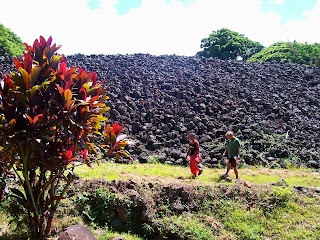
This heiau is just off a main thoroughfare near the city of Kailua. I don’t know how many times I have been by this place and because of heavy traffic totally missed seeing it. Legend has it (in other words, no one knows for sure) that it was built by the menehunes (the little people of the islands) way before contact with even the Tahitians. Now, that’s going back a far piece… This top level of the heiau is 140 feet by 180 feet. It sits up on a plateau and from the bottom it is overwhelming. It is located right behind the Y—or, rather I guess it would be more correct to say that the Y built near it—the heiau being first on the scene by maybe 1,000 years and the Y an interloper, as it were. The chattering of children broke the silence, which is probably delightful to the spirits—they seem to like the laughter of children. In the distance are the Oneawa Hills between the towns of Kailua and Kaneohe.

This is taken from the bottom of the heiau—the easternmost side. I was glad that the two people were walking through—gives some idea of how tall this heiau is—a full 30 feet the guide book says, and I would say it looks every bit of it and then some. I was standing across the stream when I took his picture. After I explored a bit, I came back along the path that these folks are walking and looked up the pile of rocks. It was breathtaking—quite an enormous amount of stone. The plants in the foreground are red ti. Ti is considered a spiritual plant—very cleansing.

The flat stones are lined up in a double row and lead down to a spring at the northwest corner of the heaiu. This is the “Menehune Pathway”. The menehune—the little people—are said to have built this heiau by carrying stones from Kualoa, or from Ewa or from as far away as Waianae. If the last two quarry sites are true, then the stones had to be transported over the Pali. From any of the mentioned sites, the stones traveled a long way.

There are two small pools, each about three feet wide, where it is said the priests brought the pigs to be washed before they were sacrificed on the altar of the heiau. The shadow in the water? Mine.

It is thought that this heiau might have been used for agricultural purposes due to the fact that the taro patches are right below it. That would make the taro patches as old as the heiau. In the middle of the picture are a couple of banana trees, and on either side, coconut palms. Even though it was close to the thoroughfare—I could hear the swish-swish of tires on the asphalt and see the cars driving by, it was quiet and peaceful in the taro patch. This is definitely a place I will return.

Pandanas, lauhala, and screwpine are just a few of the names of this plant, which is found all over the South Pacific. The weavers go through a long process—picking up the fallen leaves, taking off the thorns on the edges, washing the leaves, then boiling them, letting them dry, cutting them into the desired width—all to make a hat or mat, basket or sail for the voyaging canoe. One of my students said that the people of Puna, on the Big Island, have eyelashes like lauhala. I looked in her beautiful eyes and saw the same curve. “I take it you’re from Puna?” She just smiled. Another student did a report on lauhala and told of it’s many uses—would that I remembered more…

No comments:
Post a Comment